| ________________
CM . . .
. Volume XX Number 20. . . .January 24, 2014 
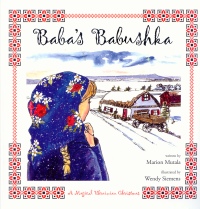 |
Baba’s Babushka: A Magical Ukrainian Christmas.
Marion Mutala. Illustrated by Wendy Siemens.
Regina, SK: Your Nickel’s Worth Publishing, 2010.
40 pp., pbk., $14.95.
ISBN 978-1-894431-53-8.
Subject Headings:
Christmas-Ukraine-Juvenile literature.
Ukrainians-Social life and Customes-Juvenile literature.
Grades 1-5 / Ages 6-10.
Review by Joanne Peters.
*** /4
|
| |
|
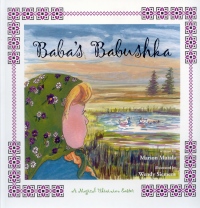 |
Baba’s Babushka: A Magical Ukrainian Easter.
Marion Mutala. Illustrated by Wendy Siemens.
Regina, SK: Your Nickel’s Worth Publishing, 2012.
40 pp., pbk., $14.95.
ISBN 978-1-894431-70-5.
Subject Headings:
Easter-Ukraine-Juvenile fiction.
Ukrainians-Social life and customs-Juvenile fiction.
Grades 1-5 / Ages 6-10.
Review by Joanne Peters.
*** /4
|
| |
|
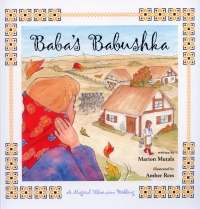 |
Baba’s Babushka: A Magical Ukrainian Wedding.
Marion Mutala. Illustrated by Amber Rees.
Regina, SK: Your Nickel’s Worth Publishing, 2013.
48 pp., pbk., $14.95.
ISBN 978-1-927756-06-5.
Subject Headings:
Weddings-Ukraine-Juvenile literature.
Ukrainians-Social life and customs-Juvenile literature.
Grades 1-5 / Ages 6-10.
Review by Joanne Peters.
*** /4
|
| |
|

excerpt:
Snowflakes fell softly from the cloudy gray sky as Natalia sang to herself. “Tray-lya-lya,
tra-lya-lya.” She twirled and danced, tossing her blonde braids back and forth, the cold of the Saskatchewan winter making her cheeks bright and rosy and her song come out in breathy wisps....
Snow drifted down onto her hair, face and eyelashes. It was almost Sviat Vechir, Christmas Eve, and mama had sent her out to play while she finished making their special dinner....She waved cheerfully at her mama standing at the kitchen window of their old prairie farmhouse. Mama smiled and waved back. As far away as she was, Natalia could tell Mama’s eyes were twinkling the same way Baba’s bright sky-blue ones had, crinkling up at the corners when she smiled.
Natalia had loved her baba very much. Baba was in heaven, and though Natalia missed her every day, she knew Baba watched over her. (From Baba’s Babushka: A Magical Ukrainian Christmas.)
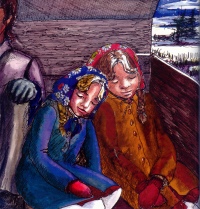 Suddenly, rainbows appear, and instead of snowflakes, flowers float down. Something else falls from the sky, a flowered blue babushka (head scarf, or kerchief) which lands on Natalia’s head and transports her to another place and time: a farm in rural Ukraine, sometime in the late 1800’s. While much about the farm looks familiar, Natalia knows she’s not in 20th century Saskatchewan. Once inside the farmhouse, Natalia hears the familiar strains of the traditional Ukrainian Nativity hymn, Boh Predvichnyj! (God Eternal). The family who lives in that straw-thatched, whitewashed farm house is ready to sit down to their Christmas Eve dinner: 12 meatless dishes, the table centred with three braided rounds of bread stacked on top of each other, and an empty place setting at the table, in memory of those who longer share a place at the earthly table. When Natalia speaks to a blue-eyed little girl of her age, she gets no response; the people at the table are oblivious to her presence, although no one seems to notice that she is enjoying the food as much as anyone else! After supper, everyone attends the evening service at the village church. “Though it was only a village church, the magnificence of the service, the prayers, the chanting, the music was mesmerizing. Natalia felt like she was in a dream.” Riding home from church in a horse-drawn wagon, she nestles against the little blue-eyed girl who also wears a flowered babushka. And when Natalia awakens on Christmas Day, the first thing she sees is the photo of Baba as a little girl. Then, she realizes that somehow, she had spent Sviat Vechir in Ukraine, with her baba’s family. Perhaps there was something magical about that blue babushka that fell from the sky. Suddenly, rainbows appear, and instead of snowflakes, flowers float down. Something else falls from the sky, a flowered blue babushka (head scarf, or kerchief) which lands on Natalia’s head and transports her to another place and time: a farm in rural Ukraine, sometime in the late 1800’s. While much about the farm looks familiar, Natalia knows she’s not in 20th century Saskatchewan. Once inside the farmhouse, Natalia hears the familiar strains of the traditional Ukrainian Nativity hymn, Boh Predvichnyj! (God Eternal). The family who lives in that straw-thatched, whitewashed farm house is ready to sit down to their Christmas Eve dinner: 12 meatless dishes, the table centred with three braided rounds of bread stacked on top of each other, and an empty place setting at the table, in memory of those who longer share a place at the earthly table. When Natalia speaks to a blue-eyed little girl of her age, she gets no response; the people at the table are oblivious to her presence, although no one seems to notice that she is enjoying the food as much as anyone else! After supper, everyone attends the evening service at the village church. “Though it was only a village church, the magnificence of the service, the prayers, the chanting, the music was mesmerizing. Natalia felt like she was in a dream.” Riding home from church in a horse-drawn wagon, she nestles against the little blue-eyed girl who also wears a flowered babushka. And when Natalia awakens on Christmas Day, the first thing she sees is the photo of Baba as a little girl. Then, she realizes that somehow, she had spent Sviat Vechir in Ukraine, with her baba’s family. Perhaps there was something magical about that blue babushka that fell from the sky.
 The next book in the series, Baba’s Babushka: A Magical Ukrainian Easter, continues the story of Natalia and her baba, this time focusing on Easter (known as Velykden, or “the Great Day” of Christ’s Resurrection). The Easter tradition best known to non-Ukrainians is the making of pysanky, beautifully decorated Easter eggs, written on with a wax stylus (in Ukrainian, the word pysaty means “to write”) and dyed in a series of colours until the wax is melted from the egg, revealing it in all of its glory. As this would be the family’s first Easter without her baba, Natalia has decorated an egg in her memory. “The egg had turned out so well, Natalia had kept it in her pocket so she could look at it whenever she wanted.” It is spring and warm enough to stay outside; inside the farmhouse, her mother is baking paska (Ukrainian Easter bread), and expert bakers know that the bread can fall if children are loud or doors slam. So, Natalia gazes into the sky, remembering her baba, missing her terribly, when rain starts to fall. This time, the raindrops become spring flowers, and once again, the flowers become a green babushka “that covered her hair and warmed her ears despite the brisk breeze.” The next book in the series, Baba’s Babushka: A Magical Ukrainian Easter, continues the story of Natalia and her baba, this time focusing on Easter (known as Velykden, or “the Great Day” of Christ’s Resurrection). The Easter tradition best known to non-Ukrainians is the making of pysanky, beautifully decorated Easter eggs, written on with a wax stylus (in Ukrainian, the word pysaty means “to write”) and dyed in a series of colours until the wax is melted from the egg, revealing it in all of its glory. As this would be the family’s first Easter without her baba, Natalia has decorated an egg in her memory. “The egg had turned out so well, Natalia had kept it in her pocket so she could look at it whenever she wanted.” It is spring and warm enough to stay outside; inside the farmhouse, her mother is baking paska (Ukrainian Easter bread), and expert bakers know that the bread can fall if children are loud or doors slam. So, Natalia gazes into the sky, remembering her baba, missing her terribly, when rain starts to fall. This time, the raindrops become spring flowers, and once again, the flowers become a green babushka “that covered her hair and warmed her ears despite the brisk breeze.”
As in the story of Ukrainian Christmas, Natalia once again finds herself in her grandmother’s village just in time to hear people singing Khrystos Voskres! (Christ is Risen!) as they walk in procession to church in the early hours of the morning. Of course, Baba is on her way to church, too, but time has passed since Natalia’s Christmas Eve adventure. Baba is now a young lady, and following the Easter liturgy and during the traditional blessing of food baskets (after which people can end their 40 day fast and enjoy that paska), Natalia notices that Baba has her eye on a very handsome young man. In Baba’s basket is a special pysanka, and she has made it with great care. “Baba’s going to give it to that boy!” Natalia realized. “She must really like him.” But in her nervousness, Baba drops the egg! However, Natalia comes to the rescue: she places her own special pysanka in the grass (in Ukraine, and even at some churches in Canada, Easter basket blessing takes place outdoors), and by some miracle, Baba sees the egg and gives it to the boy that she likes. When Natalia wakes from her reverie, it is time for her to help her mother assemble their Easter basket in time for blessing at church on the next day. At Christmas, Natalia received a carved wooden chest that had belonged to Baba. She placed her Christmas babushka in that box, and now, she has one from her Easter adventure.
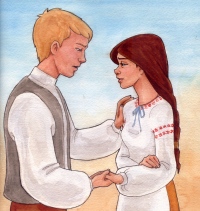 The final book in the Baba’s Babushka series is the tale of A Magical Ukrainian Wedding. It is autumn, and Natalia is supposed to be cleaning her room to get ready for the Thanksgiving visit of her extended family. But she becomes distracted, looks out her window and, certain that she can see her grandmother's face and twinkling eyes, she runs outside. The wind is scattering the fallen leaves, and, as they swirl around her head, they turn into flowers bedecking a bright red babushka. It’s time for another adventure, and this one takes her back to Baba’s village in Ukraine. Baba, whose name is Sophie, is now a grown woman, and her quiet rural existence is threatened; soldiers are on the march and war threatens. The handsome young man to whom she gave the pysanka in A Magical Ukrainian Easter is Stefan, and he wants to emigrate to Canada where he will have his own farm. “Sophie, will you be my wife and come with me?” the young man asked. Sophie accepts the proposal and preparations for their wedding begin. The final book in the Baba’s Babushka series is the tale of A Magical Ukrainian Wedding. It is autumn, and Natalia is supposed to be cleaning her room to get ready for the Thanksgiving visit of her extended family. But she becomes distracted, looks out her window and, certain that she can see her grandmother's face and twinkling eyes, she runs outside. The wind is scattering the fallen leaves, and, as they swirl around her head, they turn into flowers bedecking a bright red babushka. It’s time for another adventure, and this one takes her back to Baba’s village in Ukraine. Baba, whose name is Sophie, is now a grown woman, and her quiet rural existence is threatened; soldiers are on the march and war threatens. The handsome young man to whom she gave the pysanka in A Magical Ukrainian Easter is Stefan, and he wants to emigrate to Canada where he will have his own farm. “Sophie, will you be my wife and come with me?” the young man asked. Sophie accepts the proposal and preparations for their wedding begin.
While the previous two books depicted traditions still practiced at Christmas and Easter by many contemporary Ukrainian Canadians, the story of Sophie and Stefan’s wedding offers insight into Ukrainian betrothal and wedding customs which might not be as familiar, especially to third or fourth-generation assimilated Canadians. But, familiar or not, we feel as if we are guests at this event, and Natalia is truly awed at the privilege of witnessing the beginning of her grandparents’ married life and their courageous, but difficult, decision to leave family, friends, and all that is familiar to them for a new life in Canada. Most important for Natalia is seeing the “head-covering” ceremony when Sophie’s wedding wreath of flowers is removed from her head and replaced with a white babushka, symbolizing that she was now a married woman.
Natalia felt tears sting her eyes; the babushka Baba now wore looked exactly like the one Natalia remembered from the wedding photo hanging on the living room wall at home in Hafford. It was the same babushka her mama had worn on her own wedding day. One day, Mama would place that babushka on Natalia’s head, too, and the tradition would continue.
Each of the books in Marion Mutala Baba’s Babushka series can be read by itself, but, because the books trace Baba’s life story from girlhood to adulthood, the series works best if read in sequence. The continuation of cultural tradition within a family, the special love that grandchildren can have for their grandparents, and the importance of holding on to one’s heritage inform all three of the books. By focusing on the two major liturgical celebrations of Christmas and Easter, as well as depicting Baba and Dido’s wedding, Mutala has incorporated the details of centuries-old tradition in a way that works naturally within the narrative. I think that books would find an audience amongst Canadian girls of Ukrainian heritage – few boys will be interested in time travel enabled by a flowered head scarf, and the story’s focus is definitely on the relationship between grandmother and granddaughter. Readers will certainly see the connections between current cultural practices (especially those involving food) which have been retained or learn about customs which would have been familiar to past generations.
The illustrations of the first two books have a naïve, folkloric quality, reminiscent to me of the art of William Kurelek. A different artist provided the illustrations in A Magical Ukrainian Wedding and, as a result, drawings are rendered in much brighter colours and both Natalia and Sophie look different from their presentation in the previous books. Each book is only 48 pages long, featuring a full-colour illustration facing each page of text; oddly, the books are unpaginated. Readers whose knowledge of Ukrainian is minimal will appreciate Mutala’s inclusion of a Glossary and pronunciation guide. And, because each of the celebrations has a special food made and served only for that occasion, at the end of the book, Mutala has provided basic recipes for kutya (the wheat porridge eaten as the first dish of the Svia Vechir dinner), Paska (Easter bread), and Korovai (the elaborately decorated round braided bread which is featured at a Ukrainian wedding.)
The three Baba’s Babushka books are a worthwhile acquisition for elementary school libraries and resource collection in schools which offer Ukrainian language programing, and for public libraries serving communities with significant Ukrainian-Canadian populations.
Recommended.
Joanne Peters, a retired teacher-librarian, lives in Winnipeg, MB. Joanne is equally proud to be a fourth-generation Canadian and of her Ukrainian heritage. Her Pra-Baba (Great-Grandmother) was renowned for her expertise as a baker of traditional Ukrainian breads (as was Natalia's mother), and upon making her first batch of paska (Easter bread), Joanne's Mama told her, "You have the gift." While a different gift from a babushka, it’s one that Joanne is happy to share with friends and family at Easter time. Bread is revered by Ukrainians, and she is especially proud to be able to maintain this tradition which she has passed along to her niece and nephew.

To comment
on this title or this review, send mail to cm@umanitoba.ca.
Copyright © the Manitoba Library Association. Reproduction for personal
use is permitted only if this copyright notice is maintained. Any
other reproduction is prohibited without permission.
NEXT REVIEW |
TABLE OF CONTENTS FOR THIS ISSUE
- January 24, 2014.
AUTHORS |
TITLES |
MEDIA REVIEWS |
PROFILES |
BACK ISSUES |
SEARCH |
CMARCHIVE |
HOME |



 Suddenly, rainbows appear, and instead of snowflakes, flowers float down. Something else falls from the sky, a flowered blue babushka (head scarf, or kerchief) which lands on Natalia’s head and transports her to another place and time: a farm in rural Ukraine, sometime in the late 1800’s. While much about the farm looks familiar, Natalia knows she’s not in 20th century Saskatchewan. Once inside the farmhouse, Natalia hears the familiar strains of the traditional Ukrainian Nativity hymn, Boh Predvichnyj! (God Eternal). The family who lives in that straw-thatched, whitewashed farm house is ready to sit down to their Christmas Eve dinner: 12 meatless dishes, the table centred with three braided rounds of bread stacked on top of each other, and an empty place setting at the table, in memory of those who longer share a place at the earthly table. When Natalia speaks to a blue-eyed little girl of her age, she gets no response; the people at the table are oblivious to her presence, although no one seems to notice that she is enjoying the food as much as anyone else! After supper, everyone attends the evening service at the village church. “Though it was only a village church, the magnificence of the service, the prayers, the chanting, the music was mesmerizing. Natalia felt like she was in a dream.” Riding home from church in a horse-drawn wagon, she nestles against the little blue-eyed girl who also wears a flowered babushka. And when Natalia awakens on Christmas Day, the first thing she sees is the photo of Baba as a little girl. Then, she realizes that somehow, she had spent Sviat Vechir in Ukraine, with her baba’s family. Perhaps there was something magical about that blue babushka that fell from the sky.
Suddenly, rainbows appear, and instead of snowflakes, flowers float down. Something else falls from the sky, a flowered blue babushka (head scarf, or kerchief) which lands on Natalia’s head and transports her to another place and time: a farm in rural Ukraine, sometime in the late 1800’s. While much about the farm looks familiar, Natalia knows she’s not in 20th century Saskatchewan. Once inside the farmhouse, Natalia hears the familiar strains of the traditional Ukrainian Nativity hymn, Boh Predvichnyj! (God Eternal). The family who lives in that straw-thatched, whitewashed farm house is ready to sit down to their Christmas Eve dinner: 12 meatless dishes, the table centred with three braided rounds of bread stacked on top of each other, and an empty place setting at the table, in memory of those who longer share a place at the earthly table. When Natalia speaks to a blue-eyed little girl of her age, she gets no response; the people at the table are oblivious to her presence, although no one seems to notice that she is enjoying the food as much as anyone else! After supper, everyone attends the evening service at the village church. “Though it was only a village church, the magnificence of the service, the prayers, the chanting, the music was mesmerizing. Natalia felt like she was in a dream.” Riding home from church in a horse-drawn wagon, she nestles against the little blue-eyed girl who also wears a flowered babushka. And when Natalia awakens on Christmas Day, the first thing she sees is the photo of Baba as a little girl. Then, she realizes that somehow, she had spent Sviat Vechir in Ukraine, with her baba’s family. Perhaps there was something magical about that blue babushka that fell from the sky. The next book in the series, Baba’s Babushka: A Magical Ukrainian Easter, continues the story of Natalia and her baba, this time focusing on Easter (known as Velykden, or “the Great Day” of Christ’s Resurrection). The Easter tradition best known to non-Ukrainians is the making of pysanky, beautifully decorated Easter eggs, written on with a wax stylus (in Ukrainian, the word pysaty means “to write”) and dyed in a series of colours until the wax is melted from the egg, revealing it in all of its glory. As this would be the family’s first Easter without her baba, Natalia has decorated an egg in her memory. “The egg had turned out so well, Natalia had kept it in her pocket so she could look at it whenever she wanted.” It is spring and warm enough to stay outside; inside the farmhouse, her mother is baking paska (Ukrainian Easter bread), and expert bakers know that the bread can fall if children are loud or doors slam. So, Natalia gazes into the sky, remembering her baba, missing her terribly, when rain starts to fall. This time, the raindrops become spring flowers, and once again, the flowers become a green babushka “that covered her hair and warmed her ears despite the brisk breeze.”
The next book in the series, Baba’s Babushka: A Magical Ukrainian Easter, continues the story of Natalia and her baba, this time focusing on Easter (known as Velykden, or “the Great Day” of Christ’s Resurrection). The Easter tradition best known to non-Ukrainians is the making of pysanky, beautifully decorated Easter eggs, written on with a wax stylus (in Ukrainian, the word pysaty means “to write”) and dyed in a series of colours until the wax is melted from the egg, revealing it in all of its glory. As this would be the family’s first Easter without her baba, Natalia has decorated an egg in her memory. “The egg had turned out so well, Natalia had kept it in her pocket so she could look at it whenever she wanted.” It is spring and warm enough to stay outside; inside the farmhouse, her mother is baking paska (Ukrainian Easter bread), and expert bakers know that the bread can fall if children are loud or doors slam. So, Natalia gazes into the sky, remembering her baba, missing her terribly, when rain starts to fall. This time, the raindrops become spring flowers, and once again, the flowers become a green babushka “that covered her hair and warmed her ears despite the brisk breeze.” The final book in the Baba’s Babushka series is the tale of A Magical Ukrainian Wedding. It is autumn, and Natalia is supposed to be cleaning her room to get ready for the Thanksgiving visit of her extended family. But she becomes distracted, looks out her window and, certain that she can see her grandmother's face and twinkling eyes, she runs outside. The wind is scattering the fallen leaves, and, as they swirl around her head, they turn into flowers bedecking a bright red babushka. It’s time for another adventure, and this one takes her back to Baba’s village in Ukraine. Baba, whose name is Sophie, is now a grown woman, and her quiet rural existence is threatened; soldiers are on the march and war threatens. The handsome young man to whom she gave the pysanka in A Magical Ukrainian Easter is Stefan, and he wants to emigrate to Canada where he will have his own farm. “Sophie, will you be my wife and come with me?” the young man asked. Sophie accepts the proposal and preparations for their wedding begin.
The final book in the Baba’s Babushka series is the tale of A Magical Ukrainian Wedding. It is autumn, and Natalia is supposed to be cleaning her room to get ready for the Thanksgiving visit of her extended family. But she becomes distracted, looks out her window and, certain that she can see her grandmother's face and twinkling eyes, she runs outside. The wind is scattering the fallen leaves, and, as they swirl around her head, they turn into flowers bedecking a bright red babushka. It’s time for another adventure, and this one takes her back to Baba’s village in Ukraine. Baba, whose name is Sophie, is now a grown woman, and her quiet rural existence is threatened; soldiers are on the march and war threatens. The handsome young man to whom she gave the pysanka in A Magical Ukrainian Easter is Stefan, and he wants to emigrate to Canada where he will have his own farm. “Sophie, will you be my wife and come with me?” the young man asked. Sophie accepts the proposal and preparations for their wedding begin.